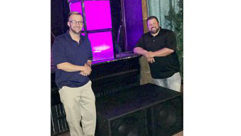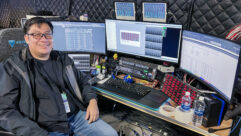
Installation Profile:
Spiritual Growth
Sep 1, 2005 12:00 PM,
By Mel Lambert
Mariners Church designs new facilities for technical performance.
The development of contemporary churches is one of continuing evolution as new facilities are added in response to the needs of parishioners, their families, and the community. Mariners Church, an interdenominational church based in Irvine, Calif., 60 miles southeast of Los Angeles, is no exception. The congregation’s first worship service was held on April 4, 1965, in a Newport Beach home, then services moved to Monte Vista School and on to Mariners Elementary School. (And hence the origin — not a nautical connection — of the church’s name.) In 1967, a full-time pastor was hired, and by 1969 the church was meeting in a small building in Corona del Mar.
The Mariners Church worship center’s new 3,200-seat auditorium holds 45 percent more people than the current area, with improved sight lines for the large stage area equipped with rear-projection screens.
Fast forward to 1998, when the church expanded onto a 25-acre campus nearby. Its Imagine 1 capital campaign initiative provided funds to purchase an additional 26 acres of land adjacent to the original campus, while Imagine 2 resulted in a remarkable $30 million for a new 63,000-square-foot children’s building called Port Mariners and a new 81,000-square-foot, multifunction worship center with an integral auditorium. Port Mariners opened officially in late June; the worship center will be inaugurated in October 2005. Imagine 3, scheduled for one to two years’ time, will add additional parking, a youth building, and a wedding chapel.
Discussing the reasoning for the church’s recent expansion, Mariners Church Technical Director Ken Robertson says, “The original worship center’s seating capacity was restricting the church’s growth. One formula that has proven true in the church market says that when you reach 80 percent capacity in your space, your growth slows dramatically. Newcomers feel there is no room for them, and they find another church to attend. This was the dilemma Mariners Church faced.”
ROOM TO WORSHIP
The new worship center’s primary area is a 3,200-seat auditorium that holds 45 percent more people than the current area. The center also includes a production studio and a multipurpose area. “We have also developed an attractive, intimate setting for smaller venues within a multipurpose lobby that was designed to seat 200 people,” Robertson says.
Much of the design direction, the technical director explains, resulted from a previous project. “Saddleback Church [Lake Forest, Calif.] was one of the largest churches in America at the time, and very well known because of its pastor, Rick Warren, author of The Purpose-Driven Life. Our building was modeled almost to the foot after Saddleback because of its flexible usages and reasonable construction costs. Yet we wanted a completely different technical performance.”
Saddleback was designed with floor-to-ceiling glass on house right and house left. “The compromise in uncontrolled lighting on the stage, house, and screens,” Robertson recalls, “combined with untreatable reflective surfaces, placed difficult demands on the AV equipment and limited its effectiveness.

The exterior of the new worship center and a rendering of the completed facility.
“While this design direction worked for Pastor Warren, we desired much more control of the light and acoustic environment. Fortunately, we were able to make significant improvements in the design. Much of this was led by Craig Janssen of Dallas-based Acoustic Dimensions.” One major improvement was in the seating plan; the stadium layout was brought closer to the platform by wrapping it high along the house-left wall, a configuration that helped break up the parallel energy while creating a more intimate feel with better sight lines.
With these areas addressed, the designers turned their attention to equipment. “We had a reasonable budget, but the word ‘unlimited’ never came up,” Robertson quips. “However, just because we could afford something didn’t necessarily make it the right choice. We soon determined that neither digital audio consoles nor HD video would be in our immediate future.”
A number of consultants and contractors worked with Robertson and Van Metschke, the chief audio engineer at Mariners Church. The primary consultant for the worship center was Acoustic Dimensions, headed by senior consultant Robert Rose, working with contractor CCI Solutions. Acoustic Dimensions senior consultant Stuart Reynolds; Diversified Systems senior engineer Robert Maniaci; and Ken Robertson and close friend Dirk Carlson designed the video systems, with Diversified as contractor. Acoustic Dimensions consultant Russ Reid designed the lighting system; Cal Stage and Lighting supplied the equipment.
“Having worked with the church three years ago on some renovations in the older buildings,” recalls Acoustic Dimensions’ Rose, “we were delighted to consult on the design of the new worship center, including the auditorium, lobby, and an upper performance area located above the new bookstore and café.” Acoustic Dimensions specializes in an integrated approach to acoustics, audio, video, and lighting for houses of worship.
“Since we don’t broadcast our service [or] mass-produce DVDs,” Robertson says, “we really didn’t consider HD; we are strictly IMAG for the house. However, we did choose to project 16:9 because that’s where the industry is headed, whether SD or HD. For our audio consoles, sonic quality was paramount, and the cost of digital consoles could not be justified for the type of services we did.” To control sound reflections within the large auditorium, Rose states, “We added MBI Lapendary panels, which are vinyl-covered, absorbent material [configured as acoustical banners] that provide a fairly inexpensive way of reducing the overall volume and dampening reflective surfaces.”
“The panels are attached to the roof,” the senior consultant continues, “and hang down in scallops that provide absorbent air pockets to increase the low-frequency performance.” An additional row of Tectum panels at the perimeter of the room also assists in reducing the amount of room volume and control reflection.
PLACING THE SCREENS
On-stage screen layout involved some important decisions. “Instead of pushing them off-stage in the typical fashion, we brought the twin 12’×21′ IMAG screens onto the stage,” says Robertson. “Although the compromise was losing some of the on-stage space for set design and staging, this design allows the congregation to keep its attention focused toward the center of the stage instead of to the side. We also added a third projector and screen that [are] floatable but usually will be in the center of the stage, either on the stage floor or on the same plane as the flanking screens. This projector is fed from the second ME on our switcher and, with the aid of our graphic designers, will become more of a set piece. Christie +16 projectors with .073 lenses were chosen for their image quality.”
The main auditorium features a 40-channel/12-group Soundcraft SM12-40 monitor console with a 20-channel Crest XR-20 sidecar mixer located stage right and a separate 48-channel/eight-stereo-group ATI Paragon II FOH console positioned in the center of the seating areas. A flown JBL Professional VerTec line array system was chosen for the installation because of its design: four clusters suspended over the platform. The asymmetry of the room required arrays of varying heights — from four to six cabinets, depending upon the required coverage. Because so few of the audience benefit from a stereo image, the sound reinforcement system is run in mono.
“We specified a VerTec array because it can provide consistent sound coverage across the width and depth of our large seating area,” states Metschke, the project’s audio coordinator. VT4888 midsize, three-way units were chosen as the upper cabinets; bottom cabinets — designated CVT4888-DF [“C” for custom; “DF” for down fill] — were designed specifically by the JBL custom products team at the request of Acoustic Dimensions to provide modified vertical and horizontal coverage. The custom cabinetry was required because flown speaker arrays could not be too tall, blocking sight lines to on-stage screens. Rather than using additional VT4888 cabinets, a practical approach was to use lower-output, wider-coverage devices suspended beneath the main arrays. The latter can cover the forward seating areas with a single enclosure.
According to Andrew Rutkin, director of custom product engineering at JBL Professional, “The CVT4888-DF features half the component count of a standard VT4888, with a downward-angled baffle: a single 12in. LF driver, two midrange drivers, and one compression driver. The combination of a reduced 6dB power output; a broader, 60-degree vertical coverage pattern; and a wider, 120-degree horizontal coverage pattern ensures that a single cabinet at the bottom of the array puts sufficient acoustical energy into the forward audience areas. In other words, the custom cabinets provide sufficient power for the application — they don’t need the full output offered by a VT4888.”

JBL VerTec line array systems provide sound coverage without blocking on-stage screens; several areas in the Port Mariners kid’s center feature Behringer SL Series audio consoles.
In the front edge of the raised stage, three poured-concrete boxes were specified to hold a subwoofer array. At the time of writing, the church was planning to hold a shoot-out to determine which components would perform best in the large environment. The soffits were sized to accommodate subwoofers from a range of manufacturers, with the thought that a combination of 15in. and 18in. drivers would be used. Hardware from EAW, JBL, and Bag End will be evaluated. To provide sound coverage at the rear of the auditorium, the designers specified seven JBL PD5322/64 cabinets and a single AM6212/64. Seven EAW UB52 compact loudspeaker systems will be used for front fill.
Signal distribution to the various Crown power amplifiers is via a series of BSS Soundweb processors from an amp room located stage right. An array of 14 Jensen JT-MS-8N3 8-channel modules provide mic splitting to the FOH and monitor consoles and a dedicated production suite. Middle Atlantic equipment racks were specified, with Bittree B96DC Series TT patch panels.
The choice of ATI Paragon II for the new auditorium was based on a long-standing desire to work with the console, says Metschke. “Previously, I was the front-of-house mixer at Saddleback Church, where we had a chance to demo the console. It’s been one of my favorite analog consoles for a long time.
“The Paragon is just a great-sounding board. It has great mic preamps and is very friendly to mix on. There are several other analog consoles in the same price range, but what pushes the Paragon over the top is that it has dynamics on every channel, [which] eliminates the need for any outboard compressors or gates.”
Three Shure PSM200, 10 Shure PSM600, and three Sennheiser EW300IEM in-ear monitor systems are available for performers, together with 16 Audio-Technica AT5000 and Shure UC4 wireless microphones.
VIDEO AND AUDIO PRODUCTION
A video production suite connects to the auditorium and other performance areas via patchable tie lines and is used to prepare live feeds to various areas — including the IMAG projection screens — in addition to recording events for later use. Image sources include four Sony D-50 video cameras located house right, two house center, and two potential positions on-stage. A Ross Synergy 2 switcher with multi-level DVE, linked to a Ross Synapse router, handles video mixing. DVCAM recorders and a Sony DR1000 hard disc unit capture the images.
A separate audio mixing suite features a Crest XVCA-48 console with an X-Matrix. Effects include six PreSonus ACP88 8-channel compressor/limiter/gates, an Aphex 320A Compellor, a Behringer Ultra-Q parametric EQ, two TC Electronic M-One XL and one M-One effects processor, and a Lexicon PCM80. A pair of JBL LSR6328SP powered cabinets and an LSR6312SP subwoofer provide monitoring. Multichannel recordings are handled by a portable rig that houses a Digidesign Pro Tools|HD DAW linked to a Mackie Onyx mixer with preamps and A/D converters. The chapel/lobby system comprises a portable Soundcraft GB4-24 console, Kramer video switcher, Shure ULXP wireless mics, six EAW LS432 line-array speakers, and Marantz and Tascam CD/cassette players. “We have provided a small stage area,” Metschke explains, “so that the lobby can be used for standalone events or fed via our BSS SoundWeb system and router with audio and video signals from the auditorium, for example, as well as other venues.” An array of Panasonic plasma screens on the walls can be fed a variety of signals as necessary.

Most areas in the new 63,000-square-foot Port Mariners building feature performance stages, multichannel sound systems, and theatrical lighting.
MAKING CHURCH FUN
“Our new two-story Port Mariners building for infants through fifth grade will help our kids invite their friends to church with a Bible-based nautical theme [designed by Florida-based Wackie World], which includes Paul’s shipwreck and Jonah and the whale,” Robertson explains. “In churches that have used this approach, subsequent attendance has increased 30 percent or more in the first few months. Kids want to bring their friends to a place that’s ‘cool.’ And if they are excited to come to church, the parents typically will follow.
“We accentuate learning with six age-specific meeting areas, complete with plasma screens, multichannel sound systems, and theatrical lighting. Full production facilities for kindergartners, we wondered? Yes — it’s one sure way if you want to capture their attention. And, for parents’ peace of mind, our IS department provided enhanced safety with movement control and security checks.”
The six AV production systems in the children’s building were designed to provide even sound coverage; all the rooms are capable of hosting a musical band. From an operation standpoint, systems in all six main rooms function identically. Within the greeting areas on both floors are two master racks that supply video and audio signals via a scaler/switcher to a large collection of plasma screens located throughout the hallways.
“Audio can follow video,” Robertson says, “or be sent separately to distributed speakers. Each rack can use the other as a slave or run independently to their respective floors. The racks also send video and audio signals to the FOH areas in each of the six rooms.” Each rack contains a Marantz PMD-371 CD changer, a BSS Audio SoundWeb 9088ii-ML, and a 9010 wall control panel, linked to arrays of Panasonic plasma screens and TV monitors and Electro-Voice ceiling speakers.
By way of an example, the second-floor main rooms each house a Behringer SL3242FX-PRO 24-channel audio mixer, an American DJ DJ400 CD player, a Marantz PMD351 CD/cassette deck, three Whirlwind/ACE stage boxes, four EV Sx100+ speakers, seven EV Sx80BE speakers, four EV Force i stage monitors with an SbA750 powered sub, a BSS Audio SoundWeb 9088iiLL, four Audio-Technica 3000 UHF body packs and receivers, and four Countryman E6 headsets. The smaller twin rooms are each provided with 16-channel Behringer mixers and a similar complement of loudspeakers and microphones, while the three first-floor holding rooms each feature an 8-channel Behringer mixer, JBL EON-powered monitors, a Symetrix 322 DSP engine, AT3000 UHF lavaliers, and Countryman headsets.
“Long ago I learned that no one person has all the answers,” Robertson reflects. “Assembling the right team makes all the difference for a successful project. We were fortunate to bring together a highly skilled, well-proven team, and we have no doubt that our highest design goals and ultimate performance capabilities have been achieved. We look forward to working with wonderful ministering tools tailored to our needs for years to come.”
For More Information
Aphex
www.aphex.com
Audio-Technica
www.audio-technica.com
Behringer
www.behringer.com
Bittree
www.bittree.com
BSS Audio
www.bssaudio.com
Christie
www.christiedigital.com
Crest Audio
www.crestaudio.com
Countryman
www.countryman.com
Electro-Voice
www.electro-voice.com
JBL Professional
www.jblpro.com
Jensen
www.audiovox.com
Kramer
www.kramerelectronics.com
Lexicon
www.lexicon.com
Mackie
www.mackie.com
Marantz
www.marantz.com
Middle Atlantic
www.middleatlantic.com
Panasonic
www.panasonic.com
PreSonus
www.presonus.com
Ross Video
www.rossvideo.com
Sennheiser
www.sennheiserusa.com
Shure
www.shure.com
Soundcraft
www.soundcraft.com
Symetrix
www.symetrixaudio.com
Tascam
www.tascam.com
TC Electronic
www.tcelectronic.com










